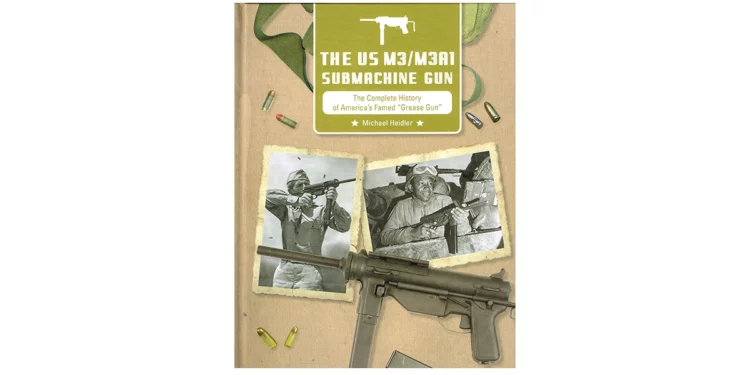By Dean Roxby –
Regular readers of SAR will no doubt recognize the name Michael Heidler, as he has contributed numerous articles over the years. He has also authored several books on military topics in his native German language. His latest book, The Complete History of America’s Famed “Grease Gun” (entirely in English) does a splendid job of covering all aspects of the M3 and the later M3A1 variant. This is fortunate as the Thompson submachine gun tends to get the lion’s share of attention when discussing American SMGs.
The M3 “grease gun” was designed as a low-cost, simple to produce submachine gun, much like the German MP 40 and the British Sten SMGs. Made from simple stampings of sheet metal, rather than requiring many complex machining operations, these guns could be produced far faster than old-school guns such as the Thompson.
As noted in chapter one, Introduction, the U.S. Ordnance Department realized the need for such a design as early as 1939. The next two chapters build on this theme, with chapter two briefly describing the Model 1921 and 1928 Thompson guns, the Reising Model 50, and the very short-lived Hyde-Inland M2. This is followed by chapter three detailing the series of trials that led to the selection of the T-20 (Renamed the M3 upon formal adoption.) Nine designs are profiled as part of the first phase of the trials, and 12 types that took part in the second phase are discussed. Several of these were existing foreign designs included for comparison only. These include the Finnish Suomi M/31, the British Sten Mk. II and Mk. III, and the Australian Austen Mk. I.
Heidler covers the early development stage as the T-20 went through further testing, including photos of a wooden “dust test” box. Having passed the dust test and a mud test, the gun was officially named the U.S. Submachine Gun, Caliber .45, M3.
This book has a great blend of WWII era B&W photos, patent drawings, US Army illustrations (Mostly from Technical Manual TM 9-217 and Field Manual FM 23-41), and modern day color detail photos. There is also a nice collection of photos and artifacts from the Guide Lamp division of General Motors. The Guide Lamp plant in Anderson, Indiana produced 688,975 grease guns during WWII.
The Accessories chapter has a good selection of the bits and pieces that gun collectors love to collect. Items shown are: oiler, brush, extractor tool (to remove the extractor pin.), sling, magazines, magazine loader, magazine pouches, large and small pouches for spare parts, and the M9 flash hider.
Chapter 14, The Grease Gun in Combat, is almost entirely photographs and captions, with only about one page of text. Naturally, most photos are from WWII, but there are several from Korea, Vietnam, and even Afghanistan and Iraq.
This leads to the next chapter, Use in Foreign Countries. Some nations were supplied with the M3 by proper means, while other countries just managed to get them somehow. China is an interesting example. As Japan was at war with both USA and China, it was logical that the USA would assist China during WWII. After WWII ended, China went back to fighting with itself. (It had been involved in a civil war between the Communists and the Nationalists since 1927, pausing during the Japanese occupation.) Eventually, the Nationalist forces withdrew to the island of Taiwan in 1949. But before this withdrawal, in 1947, the Nationalists set up a factory to produce near exact copies of the M3A1. This was named the Model 36. Shortly afterwards, in 1948, a version in 9x19mm entered production. This was called the Model 37. Soon, the Nationalists evacuated to Taiwan. There, they set up a new arms factory to produce an updated version, also in 9x19mm, called the model 39. Meanwhile, the Communist forces took over the original factory and began building the model 36 in .45 ACP once again. Heidler goes into more detail on this subject, of course. Numerous photos of the different variants are featured, including close-ups of receiver markings.
Argentina also produced their own version of the grease gun, called the PAM 1, and later the PAM 2. The difference was the PAM 2 had a grip safety added, to prevent accidental firing if the gun was dropped. Both types were chambered in 9x19mm. Again, numerous color photos are shown.
This is a fine quality book from a respected author, covering a gun that has been overshadowed by a sibling. I hope that Heidler and Schiffer Publishing collaborate on more titles. I would love to see some of the Soviet SMGs covered in similar detail.
Specs
- Title: The Complete History of America’s Famed “Grease Gun”
- Author: Michael Heidler
- ISBN: 978-0-7643-6058-9
- Copyright: 2020
- Binding: Hardcover with matching dust jacket
- Dimensions: 8.5x11in
- Pages: 224 pages
- Photos: 551 B&W and color photos and illustrations
- Publisher: Schiffer Publishing Ltd.
- Website: schifferbooks.com
- MSRP: $45












